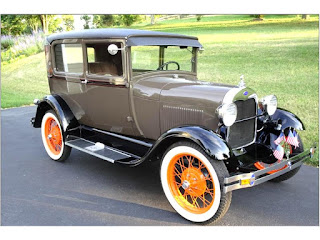Stepping into the World of Antique Cars
Going 'round the bend in your old age ...
In the forty plus years we've been in the antiques business, at one time or another, we've owned and sold just about everything considered antique. So when we decided that we wanted to buy an antique car, that's what our friends and family thought ... 'they must be going 'round the bend'
It started about a year ago. We had lunch at a diner and when leaving, we saw two beautifully restored old cars in the parking lot. "OMG, look at those" I said to my wife and we wandered over to take a look. I'd never been up close to to old cars like this and I was really impressed. They looked sort of 1920 'ish to me but I didn't really know. Spent some time looking them over and finally left.
 |
| Model 'A' Fords at a Club Event |
On the way home, out of the blue, my wife said "Why don't we get something like one of those antique cars and have some fun with it. We could do car shows, parades, cruise the countryside ... it would be great".
I had no idea what such a car could cost. Probably far more than we could afford, but I said I'd look into it, just out of curiosity, mind you. That evening I Googled something like 'antique cars for sale' and was completely blown away. One link led to another and I soon realized that there were hundreds, if not thousands available nationwide. I started looking at Google images and soon got the bug.
Obviously, you can pay just about any amount for an antique car, depending on what it is and what condition it's in. From a couple of thousand for a junk that needs fully restoring, to fabulous rare show cars that could sell in six figures. But we found that you don't necessarily have to spend more than you would for any decent used car. We were encouraged. The trick is to find a car in good condition, one that's been restored in recent years, and one that is quite common and with many companies stocking parts.
My research told me that the Model 'A' Fords, which were built between 1928 and 1931 met all the criteria and were by far, the most popular and most available antique cars of them all. There are many thousands of them still on the roads and clubs everywhere devoted to their ownership and preservation. And most important, there are several large companies in the US who stock just about every conceivable part imaginable and publish extensive fully illustrated catalogs.
When you Google 'Model A Fords' and then click on 'images', you'll see what I'm talking about. Hundreds of photos of these fabulous machines. It didn't take long before my wife and I were on a serious hunt for the perfect car for us. We saw plenty of super cars for sale out of state, but we soon learned that shipping costs are tremendous, besides, the risk you take buying sight unseen and undriven is a risk you don't want to take with a 90 year old automobile. We figured our best bet was to limit our search to no more that a two hour drive distance from our home.
 |
| 1929 Model 'A' Ford Tudor - Rose Beige color |
It looked fabulous having been completely restored. And with a few added upgrades that I would have wanted to add, anyway, (seat belts, directionals, etc.)
We were knocked out ... it exceeded our expectations and was within our budget. I drove it (well, sort of) and we bought it on the spot. No haggling. It was the same price as some of the turkeys we had previously rejected. For an extra hundred bucks the owner delivered it to our house in a closed trailer.
I was in a daze as he explained all the workings of the car and after he left, I thought of a hundred questions I should have asked. No matter, how hard can it be ... I've been driving for sixty years. I'll figure it out.
 |
| Out for a ride in the Pennsylvania countryside |
The necessary ritual of things to do before starting the car is reminiscent of starting a small aircraft and there's even adjustments you must make while driving as road conditions change. You don't just sit there and steer, like a modern car, you actually have to operate and drive this one. But you must understand that in its day, this machine represented the state of the art and a giant leap toward the modern car era from what came before.
But despite all this, it's very rewarding to be able to meet the challenge and to maneuver the beast to where you want it to go. We've done a few car shows now and it's wonderful to meet people who are truly amazed to look the car over and ask questions about it. And the wonderful sense of pride you get when driving through town and having folks wave and give you a thumbs up. I usually give 'em an 'ah-ooga' horn blast in return.
 |
| A local car show in Bethel, PA |
We got the car in late fall last year and foolishly signed up for a few local Thanksgiving and Christmas parades without really having the knowledge or the skill to safely participate. We chickened out ... but this year, we're looking forward to the same parades. A few months of experience makes all the difference.
So have we gone 'round the bend? Perhaps, but we're sure having fun along the way.
For those readers who wonder why we've deviated from our usual type of blog ... Hey, antiques is antiques!
If you have a comment or a question, contact me, Dave Young, at Blkbuggyantiques@aol.com















